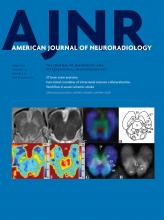Abstract
BACKGROUND AND PURPOSE: High resolution 7T MRI is increasingly used to investigate hippocampal subfields in vivo, but most studies rely on manual segmentation which is labor intensive. We aimed to evaluate an automated technique to segment hippocampal subfields and the entorhinal cortex at 7T MRI.
MATERIALS AND METHODS: The cornu ammonis (CA)1, CA2, CA3, dentate gyrus, subiculum, and entorhinal cortex were manually segmented, covering most of the long axis of the hippocampus on 0.70-mm3 T2-weighted 7T images of 26 participants (59 ± 9 years, 46% men). The automated segmentation of hippocampal subfields approach was applied and evaluated by using leave-one-out cross-validation.
RESULTS: Comparison of automated segmentations with corresponding manual segmentations yielded a Dice similarity coefficient of >0.75 for CA1, the dentate gyrus, subiculum, and entorhinal cortex and >0.54 for CA2 and CA3. Intraclass correlation coefficients were >0.74 for CA1, the dentate gyrus, and subiculum; and >0.43 for CA2, CA3, and the entorhinal cortex. Restricting the comparison of the entorhinal cortex segmentation to a smaller range along the anteroposterior axis improved both intraclass correlation coefficients (left: 0.71; right: 0.82) and Dice similarity coefficients (left: 0.78; right: 0.77). The accuracy of the automated segmentation versus a manual rater was lower, though only slightly for most subfields, than the intrarater reliability of an expert manual rater, but it was similar to or slightly higher than the accuracy of an expert-versus-manual rater with ∼170 hours of training for almost all subfields.
CONCLUSIONS: This work demonstrates the feasibility of using a computational technique to automatically label hippocampal subfields and the entorhinal cortex at 7T MRI, with a high accuracy for most subfields that is competitive with the labor-intensive manual segmentation. The software and atlas are publicly available: http://www.nitrc.org/projects/ashs/.
ABBREVIATIONS:
- ASHS
- automated segmentation of hippocampal subfields
- CA
- cornu ammonis
- DSC
- Dice similarity coefficient
- DG
- dentate gyrus
- ERC
- entorhinal cortex
- ICC
- intraclass correlation coefficient
- SUB
- subiculum
- © 2016 by American Journal of Neuroradiology
Indicates open access to non-subscribers at www.ajnr.org












